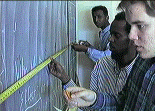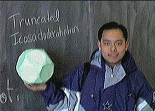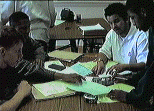
Classroom Management Plan

Dave Wiggins
Mathematics Education
University of Minnesota

Table of Contents
- Introduction
- Preventative Discipline/Management
- Assess, clarify, and communicate needs and expectations.
- Create a warm and nurturing classroom climate.
- Democratically develop a set of rules and consequences.
- Develop a daily routine, yet remain flexible.
- Make learning more attractive and fun for the student.
- Supportive and Corrective Discipline
- Deal with misbehavior, quickly, consistently, and respectfully.
- When all else fails, respectfully remove the student from the class.
- References

Introduction
The purpose of this paper is to present a classroom management plan based on discipline models presented in C.W. Charles book, Building Classroom Discipline. The paper is divided into two parts, which are in turn subdivided by management principles. The first part covers preventive discipline, while the second covers supportive and corrective discipline. It is hoped that such a plan, if implemented, would lead to all students become more respectful of others, more responsible for their education, and more effective in their practice of self-control.




Preventive Discipline/Management

Principle #1: Assess, clarify, and communicate needs and expectations.
Student and teacher needs, rights, and expectations should be openly discussed on the first day of class and reviewed periodically as a preventive measure.
- Student needs/rights/expectations: Students' basic needs include survival, belonging, power, fun, and freedom [Gl,151]. They have a right to learn without being disrupted by others. They expect the teacher to facilitate that learning by setting limits on disruptive student behavior [C,108].
- Teacher needs/rights/expectations: A teacher needs the full attention of each student. He has the right to establish optimal learning environments. He may expect behavior which contributes to optimal student growth [C,109].
- Further expectations of the student: The student is expected to come prepared to class with appropriate class materials and a willingness to learn. The students are expected to behave respectfully to the teacher and to other students. Furthermore, the student is expected to accept the consequences of misbehavior.
- Further expectations of the teacher: The teacher is expected to consider interesting curricula which meet the students' needs (listed above), to provide stimulating and useful lessons, and to always ask the students to be the best that they can be [Gl,152]. Furthermore, the teacher is expected to use teaching practices which are likely to motivate students to engage in worthwhile learning activities.
Back to Table of Contents
Principle #2: Create a warm and nurturing classroom climate.
The classroom should be a place where a student feels welcome and at home. Students need to feel safe and accepted, so ridicule and sarcasm are not allowed. Mutual respect and the Golden Rule are the key for maintaining this climate [243].
- Physical environment: The classroom should be clean and pleasantly decorated with student creations, yet free from distracting stimuli. The desks should be arranged to allow students to work cooperatively as well as allowing the teacher to circulate freely and efficiently [J,138].
- Treatment of students: Each student deserves to be treated with dignity and respect [G,66], [CM,190]. Students should be personally greeted at the door. They should be given as much personal attention as possible during and outside of class.
- Esprit de Corps: Although there are many causes of Esprit de Corps, a teacher's enthusiasm, level of concern for the students, and class involvement all can affect the level of class togetherness [207]. This force can benefit cooperative learning exercises, and make the curricula seem much more enjoyable.
Back to Table of Contents
Principle #3: Democratically develop a set of rules and consequences.
Teachers and students must create discipline plans including rules with clear and effective consequences [D,85], [C,112], [Gl,156-157]. The rules should be agreed upon and understood by everyone in the class. It should be understood that when rules are broken, consequences will be applied fairly and consistently.
- Jointly develop class rules based on expectations and needs: The teacher solicits help to develop a set of classroom rules and responsibilities [C,89]. The ideal list would be short and reflect the concepts of mutual respect and personal responsibility.
- Discuss Logical Consequences: Logical consequences are results which consistently follow certain behavior. They are explained in advance and agreed to by the students. It is hoped that by understanding the consequences of disruptive behavior, that students will make better choices. Consequences should be related to the misbehavior so the students can see the connection. For example, if you choose not to work on your assignment, you will stay after school until it is finished [D,97-98].
- Display the rules and consequences prominently: Once the class has developed its list of rules, they should be displayed as a reminder to those who may wish to break them. This gives the teacher something to point at when requesting certain behavior to stop.
Back to Table of Contents
Principle #4: Develop a daily routine, yet remain flexible.
Students will often misbehave if they don't know exactly what they should do and when. Teachers can avoid this dilemma by installing class routines and procedures, which allow the student to begin and complete work expeditiously [RW,19].
- Every minute counts: As part of an effective routine, it is best for students to begin work immediately after the bell rings [215]. Fun problems or interesting reflection topics can be put on the overhead projector to meaningfully occupy the student until attendance is taken. The activity could lead directly into the day's lesson.
- Lesson Plans: Part of the class time should be spent covering the daily lesson. During this time it is understood that only one person speaks at a time. Students who have questions are encouraged to raise their hands to ask them. Once the lesson has been presented, and all questions have been answered, the students are allowed to work cooperatively on their assignment.
- Providing Assistance: Once the lesson has been presented, the teacher is free to answer individual student questions. During this time, the teacher must be aware of what is happening in all areas of the classroom. Therefore, it is important to give "efficient help" to the students. This type of help may also reduce the number of cases of the "dependency syndrome" - students asking questions without actually needing help [J,137-138].
- Managing assignment collection: Each class has its own basket for daily assignments. At the end of the hour, on the way out of class, students drop off their completed assignments for grading.
- Restructure or Reschedule: It is understood that lesson plans can be affected by conditions beyond the control of the teacher. (It's sunny, can't we go outside?) There may be cases where class activities must be restructured or rescheduled to accommodate the changed conditions. It is possible, with some ingenuity, to make the situation a learning experience, beneficial to all.
Back to Table of Contents
Principle #5: Make learning more attractive and fun for the student.
Schools exist for the students, and not for the teachers. It is important for the teacher to expend every effort necessary to make the curriculum relevant, the lessons interesting, and the activities enjoyable. The result will be an engaged and active participant in the learning process.
- Genuine Incentives: Students respond well to the anticipation of preferred group activities, referred to as genuine incentives by Jones. It is possible to get an entire class on task if the incentive is available to all students, and attractive to the entire group so as to merit extra effort . The incentive should be both stimulating to the students, and educationally valuable [J,135].
- Active student involvement: The teacher can make learning more attractive by giving a coherent and smoothly paced lesson presentation [K,49]. Getting the lesson going, keeping it going with smooth transitions, avoiding abrupt changes that interfere with student activity, and postponing satiation are important in maintaining positive student behavior associated with being on task.
- Seat work Variety: Teachers should vary the way they present their lessons from day to day. They may demonstrate, lead a group activity or discussion, or have students work quietly on their own. Routines can become ruts if there is not some variety to "spice things up" [K,54].
- Focus on student needs: Lesson topics should be relevant to the students if at all possible. Teaching strategies should be congruent with student learning styles. The teacher should help the students develop learning goals which are real, attainable, and a source of pride. Activities should be fun for the students [CM,197].
Back to Table of Contents

Supportive and Corrective Discipline

Principle #6: Deal with misbehavior, quickly, consistently, and respectfully.
Misbehavior is a disruption to my effectiveness as an educator. The time spent dealing with misbehaving would be better spent teaching the others. Therefore, misbehavior will be dealt with quickly and consistently with class defined consequences.
- Non-verbal communication: Body language, facial expressions, gestures, eye contact, and physical proximity all can be effective in promoting self-control by the student [J,128]. It important that a teacher is aware enough to be able to recognize when misbehavior may occur, and to have non-verbal methods to prevent escalation. Kounin refers to this level of awareness as "Withitness" [K,48].
- Reminders/Requests: It is possible that a verbal reminder of the classroom rules and consequences will be all that is necessary to stop student misbehavior [CM,193].
- Redirecting Behavior: Upon an act of misbehavior, a teacher may describe the action to the student and suggest an acceptable alternative action. The student usually only has to be reminded of what he is supposed to be doing. For example, "Instead of reading that newspaper, I would like you to work on your homework for the next five minutes. You can read the paper later."
- Dealing with attention-seeking students: If a teacher ignores an attention seeking student, the misbehavior usually escalates to a level which eventually cannot be ignored. Therefore, it is best if the teacher can redirect the students behavior, and attempt to give the student attention when he is not demanding it. This method encourages students to seek motivation from within, instead of depending on attention from without [D,93].
- Avoid Power Struggles: It is important that the authority figure in the classroom (the teacher) not engage in power struggles with students. It is best to redirect a power-seeking student's behavior by offering some position of responsibility or decision making.
- Address the behavior, not the character of the student: The teacher has the power to build or destroy student self concept and personal relationships. Good communication addresses the situation directly, letting the student decide whether their behavior is consistent with what they expect of themselves [G,67].
- Invoking Consequences: To be effective, consequences must be applied consistently [D,97]. They should never be harmful physically or psychologically to the student. When they are invoked, the student should understand that he has chosen them by misbehaving [C,113].
- Prevent Escalation: Sometimes students are unwilling to listen to the teacher. At this point, a teacher can help prevent misbehavior from escalating by talking (and listening) with the student privately, and rationally discuss the problem behavior. The privacy enhances the possibility for a constructive discussion. Confrontation with an unwilling student could make the teacher appear weak in front of the class [CM,196]
Back to Table of Contents
Principle #7: When all else fails, respectfully remove the student from the class.
Continued disruptions will not be tolerated in my classroom. They are detrimental to the overall objective that all students will become active and effective learners. Therefore, such students will be respectfully removed from class, and dealt with unconventionally.
- Insubordination Rule: This rule states: "If a student does not accept the consequence for breaking a class rule, then he or she will not be allowed to remain in the class until the consequence is accepted." This rule should be made clear to the students from the first day, and should be strictly enforced with the administrations approval, of course [CM,192].
- Conference: A teacher may request a one-on-one conference with the student to discuss a specific behavior problem. The goal of this conference is to gain insight so that helpful guidance may be provided [C,6]. For more serious behavioral matters, the teacher may also request a conference with the student's parent or guardian with the same purpose.
- Behavioral Plan: This plan is for students who do not respond to conventional discipline. The plan can be written in contract form, and should include expected behaviors for the student, positive recognition for compliance, and consequences for failing. The plan should address one or two significant problems at a time, and should use consequences which differ from the previously failed ones used by the rest of the class.
Back to Table of Contents

Reference Listing:

All references are from "Building Classroom Discipline", 5th Edition, by C.M. Charles
- [RW] The Redl-Wattenberg Model: Discipline Through Dealing with the Group
- [K] The Kounin Model: Discipline Through Classroom Management
- [G] The Ginott Model: Discipline Through Congruent Communication
- [D] The Dreikurs Model: Discipline Through Democratic Teaching and Confronting Mistaken Goals
- [C] The Cantor Model: Discipline Through Assertively Managing Behavior
- [J] The Jones Model: Discipline Through Body Language, Incentive Systems, and Efficient Help
- [Gl] The Glasser Model: Discipline Through Meeting Needs Without Coercion
- [CM] The Curwin and Mendler Model: Discipline Through Dignity and Hope


Effective classroom management makes for a very happy family!!

Your comments and suggestions are welcome!
Send e-mail to: dwiggins@math.umn.edu
Back to: Dave Wiggins' Homepage
Back to: Dave Wiggins' Resume
Thanks for visiting!



